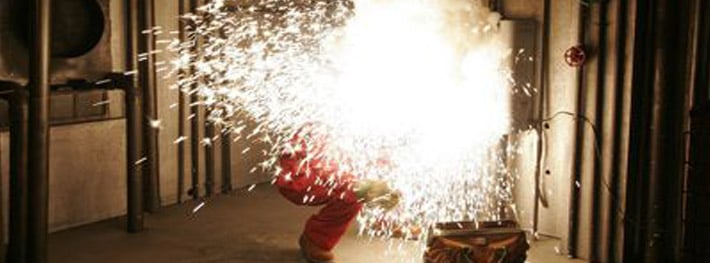Arc Flash Study & Analysis

Arc Flash Study and Analysis was first introduced by IEEE about a decade ago.
An arc flash is the light and heat produced during an arc fault. It happens when current flows through air gap in between conductors. Arc flash causes ionization of air and expels large amount of energy. The arc flash temperatures can reach upto 35,000 degrees farenheit and that is hotter than the surface of the sun.
Carelabs is competent provider of Electrical Arc Flash Study, Analysis, and Certification services in Middle-East, Africa, Asia & Europe.
Carelabs uses ETAP – Electrical Transient Analysis Program software to perform study and analysis.
The Purpose of Arc Flash Hazard Study and Analysis
The purpose of the arc flash study is to determine the protective clothing requirements for persons working on live or electrically energized equipment (whenever feasible and possible).
- Determine the risk of personnel injury as a result of exposure to incident energy (IE) released during an arc-flash event
- Provide reduced incident energy exposure if possible by using alternate protective device settings
- Provide recommendations for appropriate arc-flash hazard protection
- Comply with OSHA, NEC, and NFPA 70E requirements
Who Needs Arc Flash Hazard Study and Analysis?
Most commercial, institutional, and industrial electrical systems are prone to arc flash hazards. OSHA requires that those systems be individually analysed and, if hazards exist, labelled to identify the arc flash boundary. This will increase personnel safety, reduce shock hazards and reduce arc flash injuries. Carelabs provide arc flash studies using the ETAP software.
Working within NFPA and IEEE guidelines, our experienced power systems engineers will perform accurate systematic Arc Flash Hazard Analysis to:
- Protect electrical workers from injuries due to arc flash.
- Determine the Flash Hazard Boundary.
- Determine the PPE needed to minimize the possibility of injury due to arc flash.
Standards, Codes & Guidelines Followed
- Comply with NFPA 70E requirements
- IEEE Std 1584-2002, IEEE Guide for Performing Arc-Flash Hazard Calculations and IEEE Std. 1584a-2004 (Amendment 1)
- NFPA 70E, Standard for Electrical Safety in the Workplace 2015
Scope of Arc Flash Hazard Study and Analysis
- Data Collection
- Power System Modeling using electrical power system analysis software such as ETAP
- Short Circuit Study
- Overcurrent Protective Device Coordination Study
- Arc Flash Study
- Arc Flash Hazard Calculations
- Documentation
- Unsafe Work Locations
- Arc Flash Hazard Mitigation
- Produce full sized one line diagrams
- Final Report stamped by professional engineer
- Arc Flash Hazard Labels
- Installation of Arc flash labels
- Final Report
Arc Flash Hazard Study and Analysis Process
Carelabs offer excellent services and/or will support your site team, local electrical contractor or engineering firm with any services you need. Our expertise is widely recognized in the industry and our engineers are members of IEEE, NFPA and IEC which set the standards for arc flash studies. Our work process is:
- Data Collection
- Power System Modeling using electrical power system analysis software such as ETAP
- Short Circuit Study
- Overcurrent Protective Device Coordination Study
- Arc Flash Study
- Arc Flash Evaluation
Arc Flash Study and Analysis Report
Upon completion of the calculations, we will prepare your Arc Flash Report. This will be provided to you for a short review period, during which your team can evaluate modifications. At this point, we can hold meeting to deduce the report results. Upon approval, we will provide a final report and full sized one-line diagrams, stamped by our Registered Professional Engineer. The drawings and report will also be supplied to you in a digital format.
- Introduction
- Executive Summary
- Single Line Diagram
- Observations and Recommendations
- Labelling
- Report
Benefits of Arc Flash Hazard Study & Analysis
- Design safer power systems while applying the NEC 110.16, OSHA, NFPA 70E, IEEE 1584 and NESC standards or requirements.
- Save time with the fully integrated Short Circuit, Over-Current Coordination, Equipment Evaluation and Arc Flash Evaluation modules working together with libraries of clothing levels, protective devices and bus ratings.
- Provide a safer working environment by specifying the proper level of clothing. Wearing inadequate clothing is dangerous for obvious reasons, but wearing too much clothing is dangerous due to limited mobility and visibility.
- Evaluate alternatives quickly and easily to establish an optimal design.
- Improve safety margins with user-definable arcing fault tolerances.
- Save time by automatically generating arc flash labels and work permits.
- Avoid potential fines, lost productivity, and increased insurance and litigation costs.
Related Services
Short Circuit Study & Analysis
Electrical Switchgear Risk Assessment
Unbalanced Load Flow Study & Analysis
Voltage Imbalance Study & Analysis
Unbalanced Load Flow Study & Analysis
Relay Coordination Study & Analysis
3rd Party Inspection Of Electrical Installation
Third Party Electrical Certification
Electrical Installations Certification
Electrical Switchgear Safety Inspection
Commercial Electrical Inspection
Biomedical Equipment Safety Inspection
